上海师范大学英语专业课程教学大纲
《综合英语I》-课程教学大纲
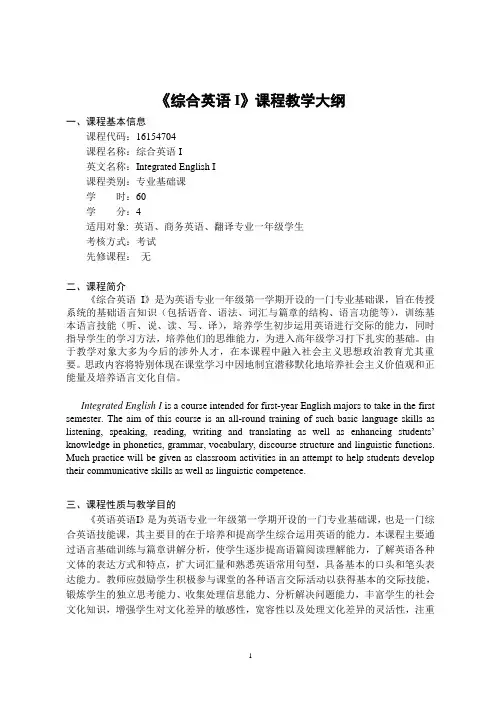
《综合英语I》课程教学大纲一、课程基本信息课程代码:16154704课程名称:综合英语I英文名称:Integrated English I课程类别:专业基础课学时:60学分:4适用对象: 英语、商务英语、翻译专业一年级学生考核方式:考试先修课程:无二、课程简介《综合英语I》是为英语专业一年级第一学期开设的一门专业基础课,旨在传授系统的基础语言知识(包括语音、语法、词汇与篇章的结构、语言功能等),训练基本语言技能(听、说、读、写、译),培养学生初步运用英语进行交际的能力,同时指导学生的学习方法,培养他们的思维能力,为进入高年级学习打下扎实的基础。
由于教学对象大多为今后的涉外人才,在本课程中融入社会主义思想政治教育尤其重要。
思政内容将特别体现在课堂学习中因地制宜潜移默化地培养社会主义价值观和正能量及培养语言文化自信。
Integrated English I is a course intended for first-year English majors to take in the first semester. The aim of this course is an all-round training of such basic language skills as listening, speaking, reading, writing and translating as well as enhancing students’knowledge in phonetics, grammar, vocabulary, discourse structure and linguistic functions. Much practice will be given as classroom activities in an attempt to help students develop their communicative skills as well as linguistic competence.三、课程性质与教学目的《英语英语I》是为英语专业一年级第一学期开设的一门专业基础课,也是一门综合英语技能课,其主要目的在于培养和提高学生综合运用英语的能力。
2023英语专业课程教学大纲
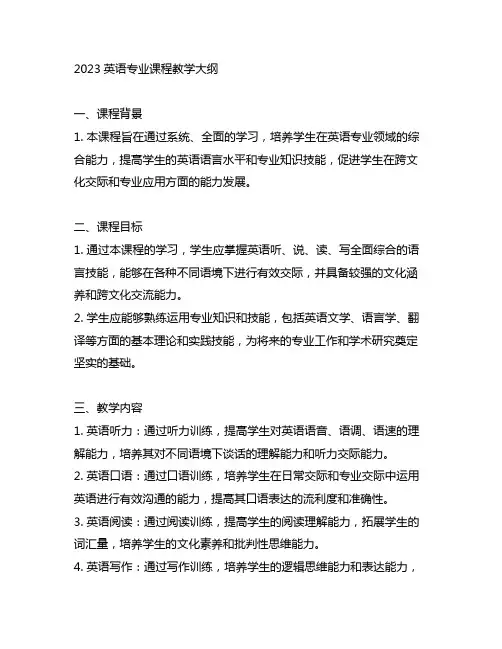
2023英语专业课程教学大纲一、课程背景1. 本课程旨在通过系统、全面的学习,培养学生在英语专业领域的综合能力,提高学生的英语语言水平和专业知识技能,促进学生在跨文化交际和专业应用方面的能力发展。
二、课程目标1. 通过本课程的学习,学生应掌握英语听、说、读、写全面综合的语言技能,能够在各种不同语境下进行有效交际,并具备较强的文化涵养和跨文化交流能力。
2. 学生应能够熟练运用专业知识和技能,包括英语文学、语言学、翻译等方面的基本理论和实践技能,为将来的专业工作和学术研究奠定坚实的基础。
三、教学内容1. 英语听力:通过听力训练,提高学生对英语语音、语调、语速的理解能力,培养其对不同语境下谈话的理解能力和听力交际能力。
2. 英语口语:通过口语训练,培养学生在日常交际和专业交际中运用英语进行有效沟通的能力,提高其口语表达的流利度和准确性。
3. 英语阅读:通过阅读训练,提高学生的阅读理解能力,拓展学生的词汇量,培养学生的文化素养和批判性思维能力。
4. 英语写作:通过写作训练,培养学生的逻辑思维能力和表达能力,提高学生撰写各种文体的能力,并培养学生的科研论文写作能力。
5. 英语文学:通过文学材料的学习,了解英语文学的发展历程和代表作品,培养学生的审美情趣和文学鉴赏能力。
6. 语言学:通过语言学理论的学习,了解语言的基本原理和发展规律,培养学生的语言分析和语言研究能力。
7. 翻译实践:通过翻译实践的训练,提高学生的翻译能力和跨文化交际能力,培养学生的翻译实践技能和专业素养。
四、教学方法1. 本课程采用多种教学方法,包括讲授、互动讨论、案例分析、项目实践等,注重理论与实践相结合,旨在激发学生的学习兴趣,提高教学效果。
2. 教师将指导学生进行课外阅读和专业实践,鼓励学生参与英语角、英文报刊阅读、英文演讲比赛等活动,为学生的综合发展提供更多机会和评台。
五、考核与评价1. 本课程采用多种考核方式,包括平时表现、课堂作业、期中考试、期末考试等,旨在全面、客观地评价学生的学习成果。
《英语师范专业教育实习》课程教学大纲【模板】
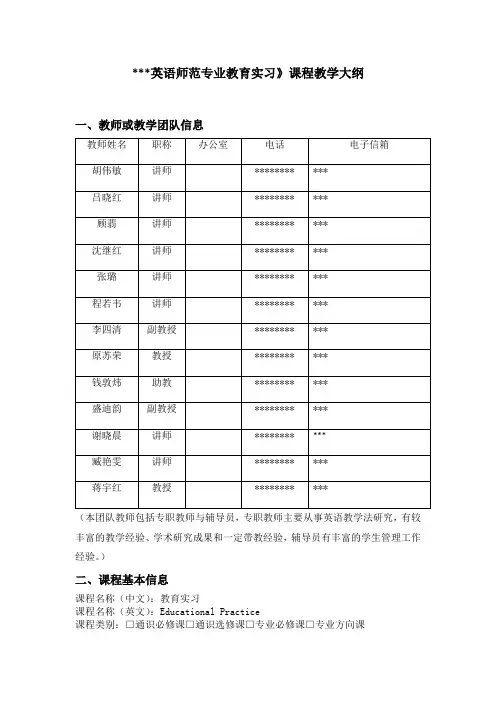
***英语师范专业教育实习》课程教学大纲一、教师或教学团队信息(本团队教师包括专职教师与辅导员,专职教师主要从事英语教学法研究,有较丰富的教学经验、学术研究成果和一定带教经验,辅导员有丰富的学生管理工作经验。
)二、课程基本信息课程名称(中文):教育实习课程名称(英文):Educational Practice课程类别:□通识必修课□通识选修课□专业必修课□专业方向课□专业拓展课 实践性环节课程性质*:□学术知识性□方法技能性□研究探索性 实践体验性课程代码:周学时: 9 总学时:48 学分: 13先修课程:完成1-3年级英语师范本科专业所有要求课程授课对象:英语师范本科生三、课程简介教育实习是高等师范院校教学计划的重要组成部分,是教师教育贯彻理论与实践相结合的原则体现,对提高教育教学质量、培养合格教师具有非常重要的作用。
教育实习是师范教育一门重要的综合实践必修课程,是培养实用型人才原则的体现,也是培养合格师资的重要措施,是使师范生获取从教知识和技能,巩固和加深对教育理论知识的理解,培养与提高教学能力,培养从事教师职业的深厚情感的重要实践环节。
教育实习不仅使学生所学专业知识、教育理论及基本技能得到运用和巩固,而且对学生不断提高教育教学质量有着重要的意义。
英语师范专业学生的教育实习是培养合格中小学英语教师必不可少的环节,通过教育实习,英语专业师范生将进一步加深对中小学学生、中小学教师、中小学课堂教学等诸方面的理解,深入学习如何当好一名英语教师、如何胜任班主任工作,把学到的英语教育理论知识与英语教学实践相结合,把所学知识转化为教学能力,不断提高自身综合素质,以胜任现代英语教师岗位的工作,为将来毕业后的实际英语教学工作打下良好基础。
因此,为提高英语师范教育专业学生的素质和从教技能,更好地适应英语基础教育改革发展的需要,科学、规范、系统地培养英语师范教育专业学生的教师职业技能,根据国家教育部颁发的《高等师范学校学生的教师专业技能训练大纲(试行)》精神,结合我院、上海市的实际,以培养英语师范教育专业学生的教学能力为核心,对学生有目的、有计划地进行系统的职业技能训练,引导学生将英语专业知识、英语学科教育学、心理学的理论与方法转化为具体从师任教的职业行为方式,并使之趋于规范化、制度化、科学化,促进学生英语教育教学能力的形成,为学生毕业后胜任英语教师工作奠定扎实的基础,特制定本英语(师范)专业教育实习教学大纲。
英语师范专业课程教学大纲
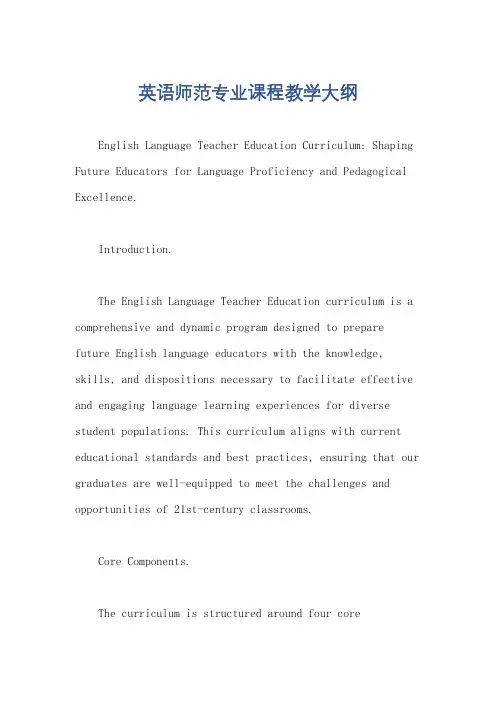
英语师范专业课程教学大纲English Language Teacher Education Curriculum: Shaping Future Educators for Language Proficiency and Pedagogical Excellence.Introduction.The English Language Teacher Education curriculum is a comprehensive and dynamic program designed to preparefuture English language educators with the knowledge, skills, and dispositions necessary to facilitate effective and engaging language learning experiences for diverse student populations. This curriculum aligns with current educational standards and best practices, ensuring that our graduates are well-equipped to meet the challenges and opportunities of 21st-century classrooms.Core Components.The curriculum is structured around four corecomponents that provide a solid foundation for English language teaching:1. Language Proficiency: Students develop a deep understanding of the English language, including its structure, grammar, vocabulary, and pronunciation. They engage in authentic language use, immersing themselves in literature, media, and cultural contexts to enhance their fluency and accuracy.2. Pedagogical Knowledge and Skills: Students acquire a comprehensive understanding of language teaching methodologies, assessment techniques, and curriculum design principles. They practice lesson planning, classroom management, and differentiation strategies, honing their ability to create effective and engaging learning environments.3. Cultural Competence: Students develop an awareness and appreciation of diverse cultures and perspectives. They explore the role of culture in language learning and teaching, fostering intercultural understanding andinclusivity in their classrooms.4. Professionalism and Ethics: Students embrace the ethical and professional responsibilities of teaching. They develop a strong professional identity, adhering to ethical guidelines and maintaining ongoing professional development to ensure their students receive the highest quality of education.Coursework.The curriculum includes a wide range of courses that cover the core components. Some key courses include:English Language Structure and Grammar.English Literature and Composition.Second Language Acquisition and Teaching.Curriculum Development for English Language Teaching.Classroom Management and Assessment.Cultural Diversity in Language Education.Professional Ethics and Development.Practicum and Field Experiences.Practicum and field experiences are integral components of the curriculum, providing students with opportunities to apply their knowledge and skills in real-world teaching settings. Students engage in supervised teaching experiences in diverse school environments, working alongside experienced educators to refine their practice.Assessment.Student learning is assessed through a variety of methods, including assignments, exams, presentations, and portfolios. Assessments are designed to measure students' proficiency in language, pedagogical knowledge, cultural competence, and professionalism.Program Goals.Upon completion of the English Language Teacher Education curriculum, graduates will be able to:Demonstrate a deep understanding of the English language and its structure.Apply effective language teaching methodologies and assessment techniques.Create and implement engaging and differentiated lesson plans that cater to diverse learner needs.Foster intercultural understanding and promote inclusivity in their classrooms.Act as ethical and responsible educators, committed to professional growth and student success.Conclusion.The English Language Teacher Education curriculum provides a comprehensive and rigorous foundation for future educators to become highly effective teachers of English. Our graduates are equipped with the knowledge, skills, and dispositions to inspire a love of language and empowertheir students to become confident and successful communicators in an increasingly globalized society.。
上外 教学大纲
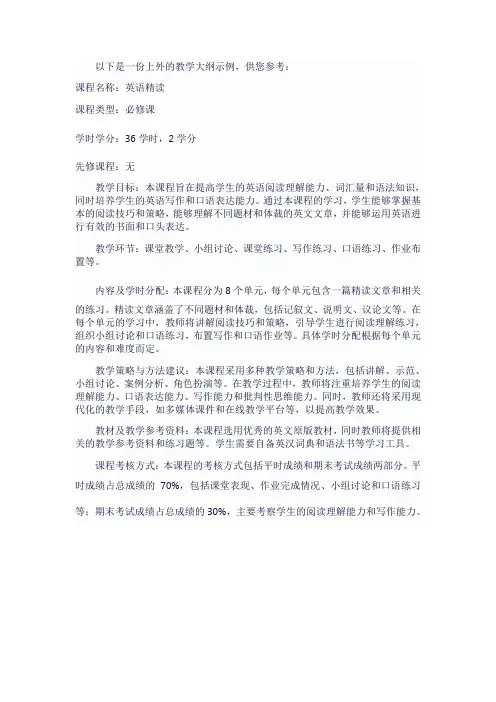
以下是一份上外的教学大纲示例,供您参考:
课程名称:英语精读
课程类型:必修课
学时学分:36学时,2学分
先修课程:无
教学目标:本课程旨在提高学生的英语阅读理解能力、词汇量和语法知识,同时培养学生的英语写作和口语表达能力。
通过本课程的学习,学生能够掌握基本的阅读技巧和策略,能够理解不同题材和体裁的英文文章,并能够运用英语进行有效的书面和口头表达。
教学环节:课堂教学、小组讨论、课堂练习、写作练习、口语练习、作业布置等。
内容及学时分配:本课程分为8个单元,每个单元包含一篇精读文章和相关
的练习。
精读文章涵盖了不同题材和体裁,包括记叙文、说明文、议论文等。
在每个单元的学习中,教师将讲解阅读技巧和策略,引导学生进行阅读理解练习,组织小组讨论和口语练习,布置写作和口语作业等。
具体学时分配根据每个单元的内容和难度而定。
教学策略与方法建议:本课程采用多种教学策略和方法,包括讲解、示范、小组讨论、案例分析、角色扮演等。
在教学过程中,教师将注重培养学生的阅读理解能力、口语表达能力、写作能力和批判性思维能力。
同时,教师还将采用现代化的教学手段,如多媒体课件和在线教学平台等,以提高教学效果。
教材及教学参考资料:本课程选用优秀的英文原版教材,同时教师将提供相关的教学参考资料和练习题等。
学生需要自备英汉词典和语法书等学习工具。
课程考核方式:本课程的考核方式包括平时成绩和期末考试成绩两部分。
平时成绩占总成绩的70%,包括课堂表现、作业完成情况、小组讨论和口语练习等;期末考试成绩占总成绩的30%,主要考察学生的阅读理解能力和写作能力。
上海师范大学外国语学院外国语言学及应用语言学培养方案
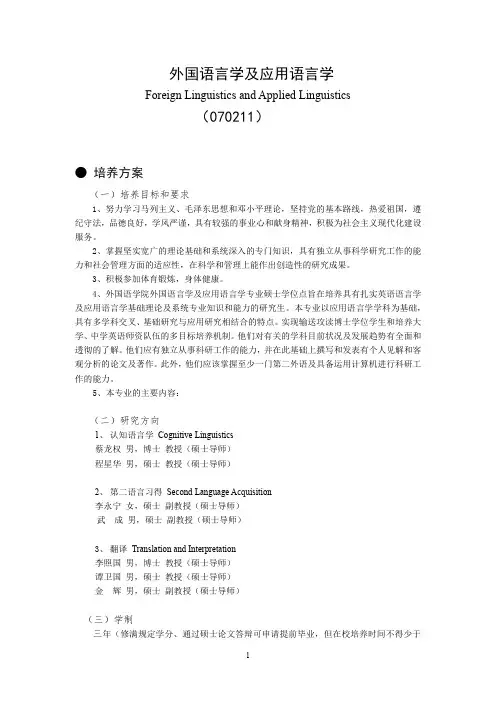
外国语言学及应用语言学Foreign Linguistics and Applied Linguistics(070211)●培养方案(一)培养目标和要求1、努力学习马列主义、毛泽东思想和邓小平理论,坚持党的基本路线,热爱祖国,遵纪守法,品德良好,学风严谨,具有较强的事业心和献身精神,积极为社会主义现代化建设服务。
2、掌握坚实宽广的理论基础和系统深入的专门知识,具有独立从事科学研究工作的能力和社会管理方面的适应性,在科学和管理上能作出创造性的研究成果。
3、积极参加体育锻炼,身体健康。
4、外国语学院外国语言学及应用语言学专业硕士学位点旨在培养具有扎实英语语言学及应用语言学基础理论及系统专业知识和能力的研究生。
本专业以应用语言学学科为基础,具有多学科交叉、基础研究与应用研究相结合的特点。
实现输送攻读博士学位学生和培养大学、中学英语师资队伍的多目标培养机制。
他们对有关的学科目前状况及发展趋势有全面和透彻的了解。
他们应有独立从事科研工作的能力,并在此基础上撰写和发表有个人见解和客观分析的论文及著作。
此外,他们应该掌握至少一门第二外语及具备运用计算机进行科研工作的能力。
5、本专业的主要内容:(二)研究方向1、认知语言学Cognitive Linguistics蔡龙权男,博士教授(硕士导师)程星华男,硕士教授(硕士导师)2、第二语言习得Second Language Acquisition李永宁女,硕士副教授(硕士导师)武成男,硕士副教授(硕士导师)3、翻译Translation and Interpretation李照国男,博士教授(硕士导师)谭卫国男,硕士教授(硕士导师)金辉男,硕士副教授(硕士导师)(三)学制三年(修满规定学分、通过硕士论文答辩可申请提前毕业,但在校培养时间不得少于两年。
)(四)课程设置与学分要求1、必修课程:Compulsory Subjects(1)学位公共课程Foundational Subjects for All Students:(需修满10学分)第二外国语(Second Foreign Language)(4学分)科学技术哲学(Philosophy of Science and Technology)(2学分)科学社会主义理论与实践(Theory and Practice of Scientific Socialism)(2学分)计算机基础(Basics of Computer)(2学分)(2)学位专业课Specialist Subjects & Options学位基础课:Specialist Subjects (需修满9学分)外语研究方法与学术论文写作Methodology for Foreign Language Research and Academic Writing(3学分)英美文学English and American Literature(3学分)语言学Linguistics(3学分)学位专业课:Specialist Options (需修满6学分)语音学Phonetics(2学分)句法学Syntax(2学分)语义学Semantics(2学分)语用学Pragmatics(2学分)应用语言学Applied Linguistics(2学分)认知语言学Cognitive Linguistics(2学分)第二语言习得Second Language Acquisition(2学分)翻译理论与实践Theories and Practice on Translation(2学分)实用文本翻译Translation of Practical Texts(2学分)外语教学法研究Theory and Practice in ELT(2学分)语料库语言学Corpus Linguistics (2学分)2、选修课程Optional Subjects (需修满6学分)文化与语言Language and culture(2学分)功能语法Functional Grammar(2学分)隐喻研究Research of Metaphor(2学分)语篇分析Discourse Analysis(2学分)心理语言学Psycholinguistics(2学分)社会语言学Sociolinguistics(2学分)学习策略Learning Strategies(2学分)课程与教材设计Curriculum and Teaching Materials(2学分)英语语言测试English Language Testing(2学分)中西翻译理论Chinese and Western Translation Theories(2学分)注:一专业与方向的学位专业课程均可作为另一专业与方向的选修课程,学分均为2。
上海师范大学课程教学大纲模板
上海师范大学课程教学大纲模板(2020年8月修订)《××××》课程教学大纲一、教师或教学团队信息(填写说明:填入负责、参与教学大纲研制和承担课程教学的教师信息。
)二、课程基本信息(填写说明:1.课程类别在相应的方框内打勾。
2.特殊课程类型指需要特别说明的课程属性,如混合式课程、教师教育课程、创新创业课程、双语课程、新生研讨课、劳动课程、社会实践课程等。
3.线上学时指具有明确学习要求,由学生自主安排学习时间完成教师在课程平台中布置的学习任务需要的学时。
学生用于线上学习的学时和线下教师面授指导学习的学时相加应等于总学时。
符合学校线上课程标准的课程,可以设定少量线下面授学时。
线下教学课程可以不设线上学时。
学校鼓励教师开设线上线下混合课程。
4.授课对象指课程面向修读学生的专业和年级。
)课程名称(中文):课程名称(英文):课程类别:□通识必修课□通识选修课□大类平台课□专业必修课□专业方向课□专业拓展课□实践性环节特殊课程类型:周学时:线上学时:线下面授学时:总学时:学分:先修课程:授课对象:大纲制定日期:三、课程简介(填写说明:阐述课程在实现毕业要求中的作用,课程在专业知识体系中的位置,课程主要内容及知识结构。
课程学习对学生专业成长具有的价值。
教师对学生投入课程学习的要求和希望。
)四、课程目标(填写说明:1.课程目标应体现课程思政的育人追求。
2.专业课程根据专业人才培养毕业要求指标点的要求制定课程目标。
3.通识教育必修课程应面向修读专业和学生,根据国家相关专业类认证的毕业要求,研究、分解指标点,制定课程目标,落实毕业要求,并与听课学院、专业充分沟通,满足培养需求。
4.通识教育选修课程应立足学校办学定位,对接各专业类国家认证标准毕业要求的通用能力和素养,制定课程目标。
4.一门课程高支撑承担毕业要求指标点的任务不宜多于3个,一门课程的目标不宜多于4个。
5.课程目标要明确通过课程学习,学生应获得的核心知识和技能,应形成的具体能力和素养。
《英语阅读》课程教学大纲
《英语阅读》课程教学大纲一、教师或教学团队信息二、课程基本信息课程名称(中文):英语阅读课程名称(英文):English Reading课程类别:□通识必修课□通识选修课 专业必修课□专业方向课□专业拓展课□实践性环节课程性质*:□学术知识性 方法技能性□研究探索性□实践体验性课程代码:周学时:2 总学时:64 学分: 2先修课程:综合英语一年级英语阅读英语语法授课对象:二年级英语师范专业和英语专业三、课程简介本课程为英语专业二年级必修课,同时也是让学生大量接触各类英语阅读材料和培养阅读能力的一门实践课。
英语阅读课程的目的在于培养学生的英语阅读习惯、阅读能力,增加词汇量和提高阅读速度;培养学生细致观察语言的能力并通过阅读训练,提高各种阅读题型完成的准确度;提高学生的阅读技能。
阅读课教学应注重阅读理解能力与提高阅读速度并重。
训练学生分析与综合、抽象与概括、多角度分析问题等多种思维能力以及发现问题、解决难题等创新能力;并注重培养学生获取英语国家的文化知识,注重培养跨文化交际能力;让学生在课程修读后达到英语专业四级要求的阅读水平。
四、课程目标本课程教学注重阅读理解能力与提高阅读速度并重,强调词汇知识学习、阅读技能训练与语言应用能力的有机结合,强调语言学习与跨文化交际能力的有机结合。
教材选用题材广泛,内容既经典又有时代感的原版引进教材《读者的选择》,以便向学生提供广泛的语言和文化素材,扩大学生的知识面,增强学生的英语语感和培养学生的阅读兴趣。
要求:1)能读懂英语国家出版的中等难度的网页文章、报纸新闻、人物故事、科普文章和文学原著,提高阅读速度,扩大词汇,能掌握主旨和大意,抓住主要论点或情节,把握阅读语篇的细节信息,并能根据所读材料进行推理和分析,从而提高阅读理解的答题准确率。
2)5—6分钟内速读1000词左右的中等难度的语篇,了解中心大意,把握主要内容,能根据上下文和构词知识猜测和判断词义。
3)独立解决大部分语言难点和一些背景知识问题,让学生积累一定的对英语国家文化、社会、时政、科技、历史和文学等方面知识。
高等学校英语专业英语大纲()
高等学校英语专业英语教学大纲一、教学目标高等学校英语专业英语教学大纲旨在培养学生具备扎实的英语基本功,掌握英语语言、文学、文化等方面的知识,提高跨文化交际能力,培养具有国际视野、创新精神和实践能力的英语专业人才。
二、教学内容1. 语言知识:学生应掌握英语语音、词汇、语法、语篇等方面的基本知识,具备较强的英语听、说、读、写、译能力。
2. 文学知识:学生应了解英美文学的发展历程,掌握英美文学的基本理论、作品和流派,提高文学鉴赏能力。
3. 文化知识:学生应了解英语国家的文化背景、历史、宗教、社会习俗等,增强跨文化交际意识。
4. 专业知识:学生应掌握英语语言学、翻译学、英语教育等领域的基本理论和方法。
三、教学要求1. 听力:能听懂英语国家人士的日常生活、学术讲座、新闻报道等不同场合的英语对话和讲话,并能正确理解其内容。
2. 口语:能流利地进行日常英语交流,具备一定的公共演讲和辩论能力。
3. 阅读:能阅读英文原版书籍、报刊、杂志等,理解文章主旨、大意和细节,提高阅读速度和理解能力。
5. 翻译:能准确翻译英文文章、合同、说明书等,掌握英汉互译的基本技巧。
6. 专业知识:掌握英语语言学、翻译学、英语教育等领域的基本理论和方法,具备一定的研究能力。
四、教学方法与手段1. 课堂教学:采用启发式、讨论式、案例分析法等多种教学方法,激发学生的主动性和创造性,提高学生的参与度。
2. 实践教学:通过英语角、演讲比赛、戏剧表演、翻译实践等活动,让学生在实际运用中提高英语能力。
3. 现代教育技术:充分利用多媒体、网络资源等现代教育技术,丰富教学手段,提高教学效果。
4. 国际交流:鼓励学生参加国际交流活动,如海外夏令营、交换生项目等,拓宽国际视野。
五、评价与考核1. 过程评价:注重学生在学习过程中的表现,包括课堂参与、作业完成、小组讨论等,以促进学生全面发展。
2. 结果评价:通过期末考试、水平测试等方式,检验学生对英语知识的掌握程度和实际运用能力。
上海师范大学外国语学院外国语言学及应用语言学培养方案
外国语言学及应用语言学Foreign Linguistics and Applied Linguistics(070211)●培养方案(一)培养目标和要求1、努力学习马列主义、毛泽东思想和邓小平理论,坚持党的基本路线,热爱祖国,遵纪守法,品德良好,学风严谨,具有较强的事业心和献身精神,积极为社会主义现代化建设服务。
2、掌握坚实宽广的理论基础和系统深入的专门知识,具有独立从事科学研究工作的能力和社会管理方面的适应性,在科学和管理上能作出创造性的研究成果。
3、积极参加体育锻炼,身体健康。
4、外国语学院外国语言学及应用语言学专业硕士学位点旨在培养具有扎实英语语言学及应用语言学基础理论及系统专业知识和能力的研究生。
本专业以应用语言学学科为基础,具有多学科交叉、基础研究与应用研究相结合的特点。
实现输送攻读博士学位学生和培养大学、中学英语师资队伍的多目标培养机制。
他们对有关的学科目前状况及发展趋势有全面和透彻的了解。
他们应有独立从事科研工作的能力,并在此基础上撰写和发表有个人见解和客观分析的论文及著作。
此外,他们应该掌握至少一门第二外语及具备运用计算机进行科研工作的能力。
5、本专业的主要内容:(二)研究方向1、认知语言学Cognitive Linguistics蔡龙权男,博士教授(硕士导师)程星华男,硕士教授(硕士导师)2、第二语言习得Second Language Acquisition李永宁女,硕士副教授(硕士导师)武成男,硕士副教授(硕士导师)3、翻译Translation and Interpretation李照国男,博士教授(硕士导师)谭卫国男,硕士教授(硕士导师)金辉男,硕士副教授(硕士导师)(三)学制三年(修满规定学分、通过硕士论文答辩可申请提前毕业,但在校培养时间不得少于两年。
)(四)课程设置与学分要求1、必修课程:Compulsory Subjects(1)学位公共课程Foundational Subjects for All Students:(需修满10学分)第二外国语(Second Foreign Language)(4学分)科学技术哲学(Philosophy of Science and Technology)(2学分)科学社会主义理论与实践(Theory and Practice of Scientific Socialism)(2学分)计算机基础(Basics of Computer)(2学分)(2)学位专业课Specialist Subjects & Options学位基础课:Specialist Subjects (需修满9学分)外语研究方法与学术论文写作Methodology for Foreign Language Research and Academic Writing(3学分)英美文学English and American Literature(3学分)语言学Linguistics(3学分)学位专业课:Specialist Options (需修满6学分)语音学Phonetics(2学分)句法学Syntax(2学分)语义学Semantics(2学分)语用学Pragmatics(2学分)应用语言学Applied Linguistics(2学分)认知语言学Cognitive Linguistics(2学分)第二语言习得Second Language Acquisition(2学分)翻译理论与实践Theories and Practice on Translation(2学分)实用文本翻译Translation of Practical Texts(2学分)外语教学法研究Theory and Practice in ELT(2学分)语料库语言学Corpus Linguistics (2学分)2、选修课程Optional Subjects (需修满6学分)文化与语言Language and culture(2学分)功能语法Functional Grammar(2学分)隐喻研究Research of Metaphor(2学分)语篇分析Discourse Analysis(2学分)心理语言学Psycholinguistics(2学分)社会语言学Sociolinguistics(2学分)学习策略Learning Strategies(2学分)课程与教材设计Curriculum and Teaching Materials(2学分)英语语言测试English Language Testing(2学分)中西翻译理论Chinese and Western Translation Theories(2学分)注:一专业与方向的学位专业课程均可作为另一专业与方向的选修课程,学分均为2。
- 1、下载文档前请自行甄别文档内容的完整性,平台不提供额外的编辑、内容补充、找答案等附加服务。
- 2、"仅部分预览"的文档,不可在线预览部分如存在完整性等问题,可反馈申请退款(可完整预览的文档不适用该条件!)。
- 3、如文档侵犯您的权益,请联系客服反馈,我们会尽快为您处理(人工客服工作时间:9:00-18:30)。
上海师范大学英语专业课程教学大纲《英语语音》一、课程基本信息授课对象:外国语学院英语语言文学专业一年级学生课程类别:必修课周课时数:2上课周数:18总学时:36考试方式:笔试和口试结合二、课程的性质、目的和任务英语语音课程是英语专业开设的一门专业基础课程。
开设的对象是英语专业一年级新生,开设的时间是一学期,是培养学生良好发音的基础学科,为必修考试课。
本课程的教学目的是通过对语音知识的系统学习和听辨、模仿等训练,使学生了解英语语音的基本知识和基本理论,掌握正确、标准的英语发音,学会使用自然得体的语音语调表达思想,以达到有效交际的目的。
正确的语音语调是英语专业学生必须具备的基本功之一,并且语音能力直接影响到听力和口语的提高。
因此语音课的任务就是让学生在正常的语流中学习英语的发音,使学生能操一口流利顺畅、清晰易懂、交际自如的英语,通过语音学习学会交际。
三、课程教学内容的基本要求、重点和难点本课程采用《英语语调的结构、功能及应用》(卜友红编著)和《英语语音教程》(王桂珍主编),教学内容基本按照课本编排的顺序实施。
内容主要包括:44个音素的发音,词重音,句重音,强读与弱读。
学生应掌握下列知识和技能:1.了解音素、音位变体、宽式标音和窄式标音、最小对立对、互补分布等基本概念;2.掌握英语44个音素的发音;3.了解英语的音节结构,掌握不同音素组合的发音;4.正确的把握词与词之间的过渡,使同一意群的词连贯、流畅地连接在一起;5.掌握每个多音节词的重音模式;熟悉并会使用单词的强读式与弱读式;6.正确地把握句子重音;掌握正确的话语节奏规律;7.正确得体地使用语调;最重要的是,通过使用正确的语音语调达到交际的目的。
8.本课程的重点和难点在于如何正确地把握重音、话语节奏规律及语调,也就是说,如何通过使用正确的语音语调达到交际的目的,形成自然流畅的语流,养成良好的口语习惯。
四、教学方式及学时分配语音课程是一门实践性比较强的课程,因此本课程采用的方法是进,讲授,举例,领读,课堂实践注重听说齐头并进。
练习形式:每单元的练习都从音的听辨入手,使学生在正确辨音的基础上开口练习。
口语练习以朗读和模仿为主,从简单的单词、句子的朗读到对话、段落的模仿直至较为复杂的、置于自然语言环境中的模仿。
练习内容:每单元的练习都从该单元的重点语音练习项目开始,帮助学生提高听音、辨音的能力和对不同的音、重音、节奏和语调的觉察力。
为了使学生能将所学得的知识自然、得体地使用出来,本教程每个单元都围绕着某个特定的语言功能展开听与说的练习,目的在于训练学生用正确的语音语调自然得体地进行会话。
教学进度:本课程共含18单元,每单元2课时,共用36课时完成。
教学内容与教学进度如下(注:可按教学实际情况适当调整):Unit 1 The Description of speech sound教学时数:2 学时教学要点:Basic concepts in Phonetics教学内容:1.Outline of the course2.Phonetics and phonology3.Main features of phonetics4.Physiology of pronunciation5.Phonetic transcription6.Phoneme and allophone7.Phonemic contrast,minimal pair and complementary distribution考核要求:To remember and understand the basic concepts.Unit 2 Vowels in English教学时数:4 学时教学要点:1.To know the three ways of describing a pure vowel.2.To get familiarized with the description of pure vowels and diphthongs accordingto the vowel chart.3.To know the characteristics of English pure vowels and diphthongs.4.To pronounce the vowels correctly.教学内容:1.Three ways of classifying or a pure vowel(1)The height of the tongue (high, mid, low)(2)The location of the tongue (front, central, back)(3)The posture of the lips (rounded or unrounded)2.Description of the twelve pure vowels according to the chart in the textbook:/i:/ /ɪ/ /e/ /æ/ /ɑː/ /ɒ/ /ɔ:/ /ʊ/ /u:/ /ɜ:/ /ə/ /ʌ/3. To considere the characteristics of the diphthongs and to describe them in termsof a movement (or ‘glide’) from one vowel position to another.4. To design a variety of classroom activities for focusing on diphthongs in theclassroom.5.To have the students listen to the conversations recorded by native speakers ofEnglish and try to get the sounds in focus correct in their pronunciation.考核要求:1.To know the three ways of describing a pure vowel.2.To get familiarized with the description of pure vowels and diphthongs accordingto the vowel chart.3.To know the characteristics of English pure vowels and diphthongs.4.To pronounce the vowels correctly.Unit 3 Consonants in English教学时数:4学时教学要点:1.To know the three ways of dividing consonants.2.To be familiarized with the description of a consonant.3.To know the three stages of a complete plosion.4.To pronounce the consonants correctly.5.To teach students some skills in articulating the consonant clusters and otherdifficult sounds.6.To raise the students awareness that Chinese has very few consonant clusters.教学内容:1. Three ways of dividing consonants(1)the places of articulation(2)the manners of articulation(3)the state of the vocal cords2. Three stages of a complete plosion /p/ /b/ /t/ /d/ /k/ /g/(1) the closure/closing(2) the stop/compression(3) the release/explosion3. Incomplete plosion4. Fricatives and Affricates /f/ /v/ /θ/ /ð/ /s/ /z/ /ʃ/ /ʒ/ /h/ /ʧ/ /ʤ/5. Nasals, Approximants and Lateral /m/ /n/ /ŋ/ /w/ /r/ /j/ /l/考核要求:1.To know the three ways of dividing consonants.2.To be familiarized with the description of a consonant.3.To know the three stages of a complete plosive.4.To pronounce the consonants correctly.5.To know the common forms of consonant clusters.6.To pronounce the consonant clusters correctly and avoid squashing any vowels in between.Unit 4 W ord Stress & Sentence Stress教学时数:2学时教学要点:1.The definition of stress2.Two kinds of stress: word stress and sentence stress教学内容:1. Word stress1)The definition of stress2)Word stress: primary stress, secondary stress and zero stress3)Stress vs. unstress in terms of loudness, pitch, vowel quality2. Sentence stress1)The definition of sentence stress2)Words usually stressed in a sentence3)Words usually unstressed in a sentence考核要求:1. Definition of stress2. Degrees of word stress3. Word stress; to get word stress correctly4. Sentence stress: to know which words are usually stressed in a sentenceUnit 5 W eakening教学时数:2学时教学要点:1.The strong and weak forms of the functional words2.The pronunciation of the weak forms教学内容:1.The importance of learning weak forms of the words2.The strong and weak forms of the functional words3.The practice of the weak forms考核要求:1.To know the strong and weak forms of the functional words.2.To know the most frequently reduced weak forms.3.To pronounce the weak forms correctly.Unit 6 Rhythm (I)教学时数:4学时教学要点:1.To raise students’ awareness of the importance of stress in English through clearly patterned rhythm in speech.2.To perceive differences between the rhythmic patterns of English and Chinese and acquire more rhythmic and fluent speech in oral communication.教学内容:1.Stress-timed rhythm vs. syllable-timed rhythm2.Metric foot in English poetry3.Rhythm and music4.Work on rhythms5.Rhythm-group6.Rhythmic structure7.Division of rhythmic group8.Work on rhythmic patterns考核要求:1. Get the students know what the rhythm is in English speech.2. Get the students to understand the rhythmic structure.3. Let the students practise common rhythmic patterns.4. Help the students to read nursery rhymes, sentences, paragraphs rhythmically.5. Ask students to read nursery rhymes, jazz chants, phrases, sentences and passages rhythmically.6. Let them work in pairs. First mark the rhythmic stress, and then read the passages.Unit 7 Liaison (Linking)教学时数:2学时教学要点:7.The definition of linking8.The different speech flows between Chinese and English9.Types of linking10.The practice of linking教学内容:1.Definition2.The different speech flows between Chinese and English3.Types of linking:1)Liaison: consonant + vowel2)Hiatus: vowel + vowel: [j]-glide and [w]-glide3)Linking [r]4)Intrusive [r]5)Practice of linking 2学时a) Give students sentences and ask them to ease the transition between words.b) Give students a passage and ask them to mark the word boundaries wherelinking is likely to occur, and then read the passage aloud.考核要求:1.To know the different types of linking.2.To read phrases, sentences and passages fluently.Unit 8 Assimilation & Elision教学时数:2 学时教学要点:1.The definition of assimilation and elision2.Kinds of assimilation and elision3.The practice of assimilation and elision教学内容:1. The definition of assimilation and elision2. Kinds of assimilation1) Direction of change2) Assimilation of voicing3) Assimilation of place of articulation4) Assimilation of manner of articulation5) Coalescence of place and manner of articulation3. Rules of elision考核要求:1. The definition of assimilation and elision2.The different kinds of assimilation and rules of elision3.The ability to find out the assimilated words in connected speech and read itnaturally and fluentlyUnit 9 Intonation教学时数:8 学时教学要点:1.Definition of intonation2.Forms of English intonation3.Types of tones4.Functions of intonation5.Application of intonation教学内容:General Introduction to Intonation 2学时1.The definition of intonation2.Tone language vs. intonation language3.Intonation group4.Transcription conventionsponents of intonation groupNuclear tone 2学时1)Kinetic Tones2)Tone I Falling (high fall and low fall)3)Tone II Rising (high rise and low rise)4)Tone III Falling-Rising5)Tone IV Rising-FallingThe Functions of Intonation and Nucleus placement 2学时1. The semantic function of intonation2. The attitudinal function of intonation3. The grammatical function of intonation4. The accentual function of intonation5. Nucleus placement1) Broad focus2) Narrow focus3) Information focus: new information vs. old informationThe application of English intonation 2 学时1.Basic meanings of the kinetic tones in English2.Intonation and sentence types3.Tone unit division and syntactic boundaries4.Application of intonation to oral communication考核要求:1.To understand the basic concepts of intonation2.To know the different types of tones3.To master the functions of intonation4.To apply the intonation to oral communicationChapter 10 General Revision教学时数:4 学时教学要点:General revision:1. Basic concepts of the theoretic knowledge offered in class.2. Written part of the revision: 1 & 23. Oral part of the revision: Oral practice教学内容:1.To review what has been presented, produced and discussed in class.2.To review the written part which cmprises a number of tasks relevant to eachlecture for individual study and reflection, or for discussion and revision in class.3.To ask students work in pairs and try to find the answer to each task.4.To offer an answer key after class.5.To ask students to listen to the oral part for focusing on phonemes, stress, rhythm,intonation and connected speech.考核要求:1.To understand the basic concepts of phonetic theories.2.To have a better pronunciation and intonation.3.To apply what has been learned to oral communication as natural and fluently aspossible.三、课程教材1. Baker, A. Ship or Sheep? London: Cambridge University Press [M]. 1981.2. 卜友红,《英语语调的结构、功能及应用》,外语教学与研究出版社,2003年第一版。
